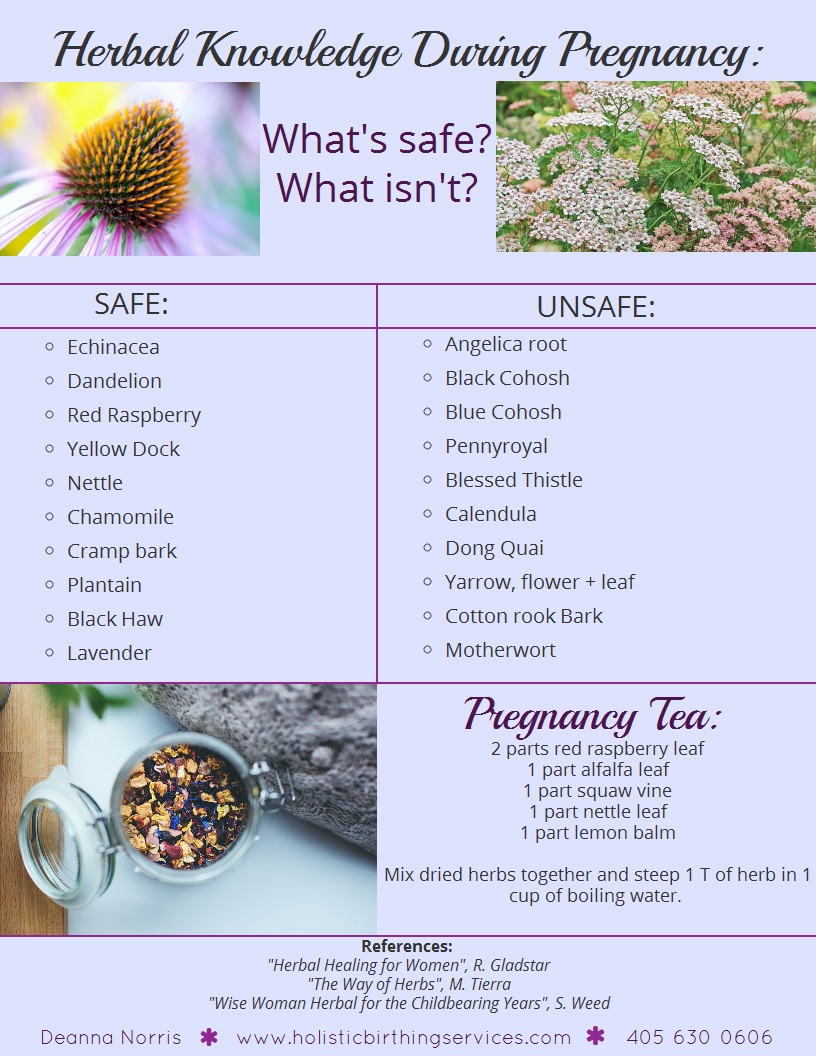Herbs and Pregnancy
Herbs are a part of every day life for many of us. From the basil in the marinara to infusions, tinctures and teas, herbs have many uses and many forms. I am often asked about the safety of herbs in pregnancy. There are many herbs, that while considered safe in pregnancy, consulting a certified herbalist is still recommended due to the many multi-faceted uses of most herbs. Just today, there was a discussion in a mother's group I am a part of about Red Raspberry Leaf. One person mentioned it was a uterine tonic; another mentioned it was a hormone balancer. It's both! This is the beauty of herbs. They are multi-functional.
Below are my top 5 herbs for use in pregnancy. Remember to consult your provider about your own health care needs when choosing an herbal regime.
1. Red Raspberry Leaf-
This herb is such a great herb for women in all aspects of life. From the young girl, just starting her cycles to the women who is going through menopause, RRL has an amazing ability to adapt to our body's needs.
Raspberry leaves are the most famous of all the herbs used during pregnancy. They have both relaxing and toning, or astringent, actions, with a particular affinity for the uterus. Throughout history, RRL has been used to speed up birth and to stimulate lactation after birth.
GRAS, no contraindications or side effects Starting in the 2nd trimester, take one cup of infusion daily, increasing to 3 cups daily in the 3rd trimester. While in labor, take a cupful every hour. Continue with this mixture after birth, 1-3 times daily, to tone and strengthen the pelvic tissues.
2. Chamomile-
A gentle herb, considered very safe, is great at relieving stress and tension. Great for babies and children. Chamomile is served in hospitals throughout Europe to calm and relax patients. Great for stomach tension, indigestion and inflammation. It is easily cultivated and beautiful in the garden. Commonly used for stress, digestive complaints, nervous disorders, inflammation in the joints, and for wounds. It is an excellent remedy for all manners of women’s disorders.
There are many uses for chamomile including thrush treatment, fever reducer, relieves tension and spasms in the digestive tract, relieves nausea and sickness in pregnancy, relieves painful periods, mastitis treatment, premenstrual headaches, eases the pain of childbirth, used as a pain reliever, used for asthma and hay fever, used externally for eczema and to heals wounds.
For medicinal purposes, try C. recuitita. Some people can experience an allergic reaction to chamomile since it is in the compositae family. Anyone who suffers from pollen-bearing plant allergies, should use with caution. Chamomile is exceptionally volatile and should not infuse for more than 30 minutes.
http://www.botanical.com/botanical/mgmh/c/chammo49.html
3. Nettle-
Common name is stinging nettle. Nettles usefulness can be traced back to antiquity and its popularity as food and medicine has hardly waned over the years. Nettles were used in ancient Greece and Rome to treat gout, rheumatism, and poisonous snake and insect bites. The tough stalk fibers were used as fabric. Steamed young nettle tops serves with olive oil, lemon juice and a bit of feta make a delicious dish according to Rosemary Gladstar, herbalist. Native American women used nettle as a tonic during pregnancy and as a remedy for treating postpartum hemorrhaging.
When taken over a long period of time, nettles are a tonic that will benefit the entire body. It’s ideal for anemia. Sprinkling the powder on a wound helps it stop bleeding. Tea is useful for asthma, chronic and acute urinary complaints, urinary stones, nephritis and cystitis, diarrhea, dysentery, hemorrhoids, chronic arthritic and rheumatic problems.
When tea is drunk during pregnancy, it helps lower high blood pressure. Drink several cups of infusion during labor to help prevent hemorrhage due to the high Vitamin K content. Nettles help with varicosities, kidney issues, encourages rich, abundant milk postpartum, are excellent for young women starting their cycles and for women in menopause.
4. Dandelion-
Also known as Lion’s teeth and fairy dock. The whole plant can be used as medicine and is highly nutritious. Roots are best harvested in the early spring and late autumn. Leaves should be picked when young in the spring and early summer. Dandelion is most famous for a gently detoxifying bitter tonic. Dandelion has high estrogen properties and is used for a lot of female issues.
Dandelion is used for digestives issues, liver disease, jaundice, enhancing the appetite, easing digestion, cleansing the liver, hepatitis, gallbladder infections, gallstones, skin problems and headaches. Dandelion increases insulin secretion, is effective as a diuretic and useful for hypoglycemia.
To use, make a standard decoction or use 10-30 drops of tincture. ½ cup infusion, every 30 minutes to treat stomach aches.
5. Echinacea-
I saved my favorite herb for last! Echinacea is my go-to for so many things. This herb is called Purple Coneflower locally. It grows wild across Oklahoma, but is also easily cultivated for personal use. I appreciate it's gentleness in easing all things in the "sick" category.
Echinacea makes our own immune cells more efficient at attacking bacteria, viruses and abnormal cells. It increases the number and activity of immune system cells, stimulates new tissue growth for wound healing and reduces inflammation and inflammatory skin conditions. It also kills yeast and slows or stops the growth of bacteria.
Echinacea purpurea has no known toxicity and has an excellent safety record, being very well tolerated by most people. However, Echinacea purpurea should not be used in progressive systemic and autoimmune disorders such as tuberculosis, leucosis, connective tissue disorders, collagenosis and related diseases.
For additional information on herbs during pregnancy, see this handy visual aid I made!
References:
“The Way of Herbs”, M. Tierra, pgs, 184-5
“Complete Women’s Herbal”, M. Tierra
“Herbal Healing for Women”, R. Gladstar,
‘Wise Women Herbal for the Childbearing Years”, S. Weed


